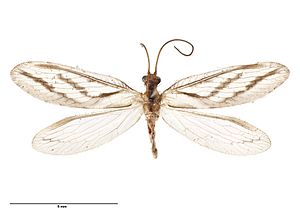Micromus bifasciatus facts for kids
Quick facts for kids Micromus bifasciatus |
|
|---|---|
 |
|
| Scientific classification | |
| Genus: |
Micromus
|
| Species: |
bifasciatus
|
| Synonyms | |
|
Micromus bifasciatus var. manapouriensis Tillyard, 1923 |
|
The Micromus bifasciatus is a cool insect known as a brown lacewing. It belongs to a family of insects called Hemerobiidae. These tiny creatures are found in places like Australasia, which includes countries such as New Zealand and Australia.
This particular lacewing was first officially described by a scientist named Robert John Tillyard in 1923.
Contents
What Does Micromus bifasciatus Look Like?
The Micromus bifasciatus is usually dark brown. Its delicate wings have veins that often look pink. This helps it blend in with its surroundings.
How to Tell it Apart
You can tell the Micromus bifasciatus apart from a similar species, the Micromus tasmaniae. The Micromus bifasciatus has two brown stripes across the front part of its wings. Think of them like little bands.
In contrast, the Micromus tasmaniae has a spotted pattern on its wings instead of stripes. This makes it easier for scientists to identify them.
What Do They Eat?
Brown lacewings like Micromus bifasciatus are helpful insects. They are known to eat small pests like scale insects and mealybugs. These tiny bugs can harm plants by sucking their sap.
By eating these pests, lacewings help keep plants healthy. This makes them a natural way to control pests in forests and gardens.
Where Does Micromus bifasciatus Live?
In New Zealand, you can find the Micromus bifasciatus in many different places. They live from the very top of the North Island all the way down to Invercargill and Stewart Island in the south.
Favorite Trees and Forests
These lacewings mostly live in native forests. They like trees such as Prumnopitys taxifolia, Dacrydium cupressinum, and Dacrycarpus dacrydioides. These are all types of trees that often have scale insects or mealybugs living on them, which is good for the lacewings' diet.
They are also often found near Podocarpus trees. So, if you're exploring a native New Zealand forest, keep an eye out for these interesting little brown lacewings!
Images for kids


